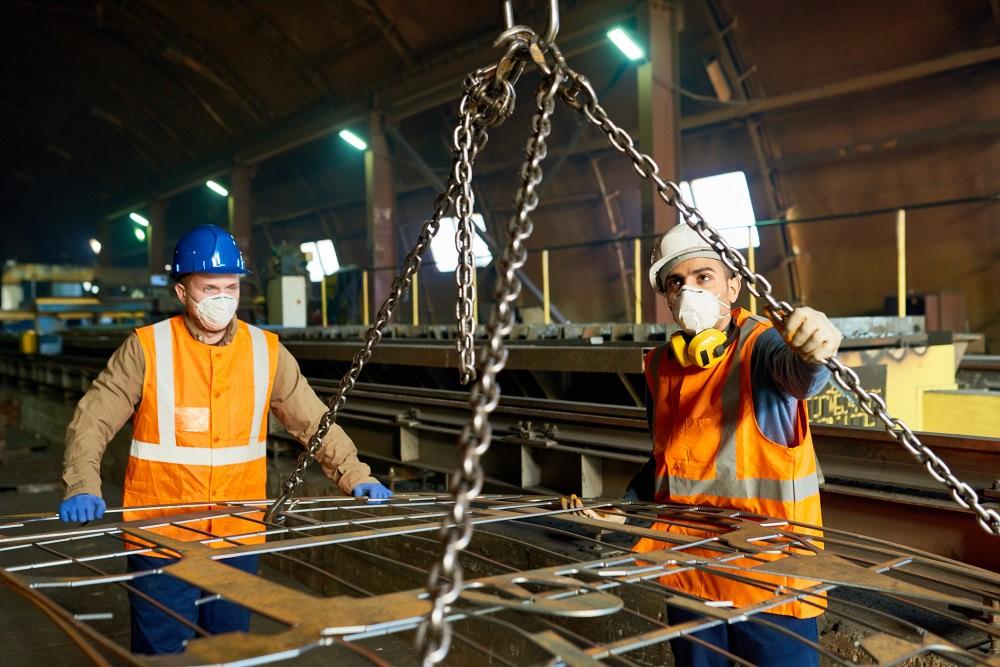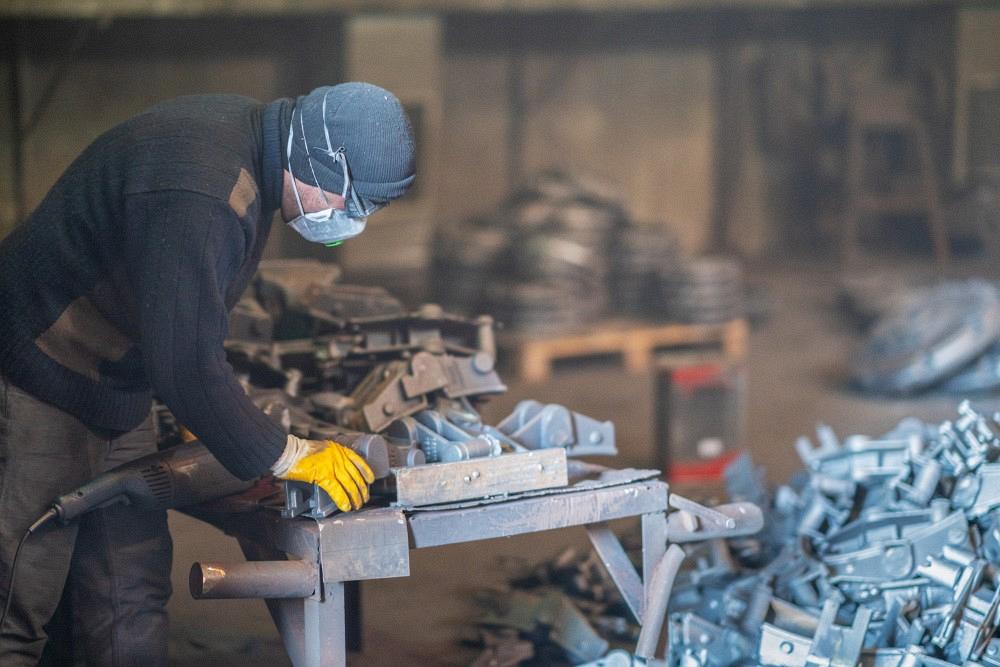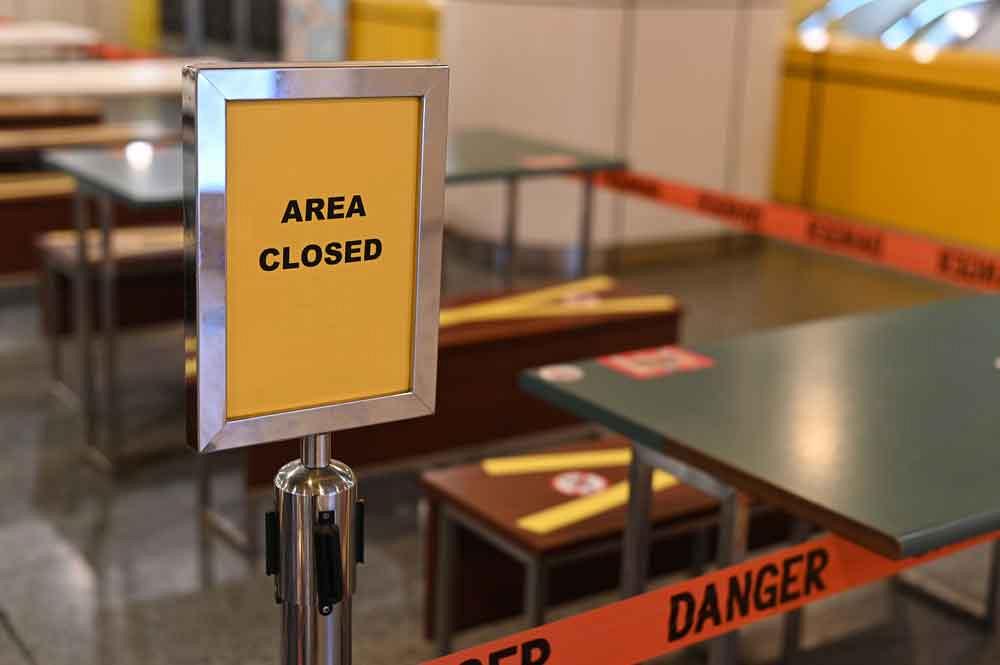Editor-in-Chief
- FMA
- The Fabricator
- FABTECH
- Canadian Metalworking
Categories
- Additive Manufacturing
- Aluminum Welding
- Arc Welding
- Assembly and Joining
- Automation and Robotics
- Bending and Forming
- Consumables
- Cutting and Weld Prep
- Electric Vehicles
- En Español
- Finishing
- Hydroforming
- Laser Cutting
- Laser Welding
- Machining
- Manufacturing Software
- Materials Handling
- Metals/Materials
- Oxyfuel Cutting
- Plasma Cutting
- Power Tools
- Punching and Other Holemaking
- Roll Forming
- Safety
- Sawing
- Shearing
- Shop Management
- Testing and Measuring
- Tube and Pipe Fabrication
- Tube and Pipe Production
- Waterjet Cutting
Industry Directory
Webcasts
Podcasts
FAB 40
Advertise
Subscribe
Account Login
Search
What a fab shop in the age of COVID-19 looks like
Keeping employees safe is priority No. 1 for metal fabrication companies

A safe metal fabrication shop in the age of COVID-19 is built on a foundation of good communication and respect for each other’s space. Getty Images
If you visited a fab shop this summer, what did you see during this time of COVID-19? Well, that’s a trick question. You probably didn’t see anything because many facilities aren’t allowing visitors, unless they are considered essential in keeping production running.
Who is welcome? The service technician who needs to get the laser cutting machine back up and running falls into that category. Who isn’t? The Boy Scout troop looking to round out their education on the way to earning their merit badges for welding.
That’s life during the pandemic. Until a vaccine is discovered, everyone needs to be careful. Even if you are pushing for herd immunity, where at least 80% of the population is immune to the virus, which helps to eradicate the virus because it must spread to live on, it takes a while; 260 million U.S. residents would need to be immune, and this country requires the testing infrastructure to validate those numbers. Like it or not, we’re all in this together for some time.
And that seems to be the message that manufacturers are spreading. Like any successful initiative in a manufacturing operation, everyone needs to be pulling in the same direction.
“During this time you want to give your employees the confidence that you know what you’re doing. A lot of that has to do with communication,” said Brian Dudgeon, senior safety professional and account executive, Optimum Safety Management, during a Metals Service Center Institute-sponsored webinar in May. “In fact, I don’t know if you can overcommunicate during this time because in the absence of communication, people make up their own narratives.”
Here are some of the best practices for getting people back to work during the pandemic that have been shared in recent months in interviews, webinars, and industry white papers. It’s not business as usual, but at least it’s business.
Before the Doors Have Even Opened ...
If an organization hasn’t developed an infectious disease control program, it needs to do that before anything else takes place. It’s like a documented lockout/tagout program or a bloodborne pathogen response plan that is already part of the company’s safety and health manual. The program documents how the company responds if someone with COVID-19 symptoms shows up at work. It also shows the Occupational Safety and Health Administration representatives that the company is serious about trying to protect its workers.
A company can use guidance from an agency like the Centers for Disease Control and Prevention, a third-party consulting company, or an industry association to formulate the plan. Company management is basically trying to figure out how the organization will respond to a viral outbreak, what it will do to minimize transmission of the virus, and what will be done if an infectious disease has been introduced to the workforce.
During another MSCI webinar in May, Brad Bullard, general manager, safety Coilplus Inc., shared what happened when four people were diagnosed with COVID-19 at one of his company’s facilities. They kept the four employees home and sent 14 people, who were identified as having come in contact with the other four employees, into quarantine at home. Management shut down the plant for a day and conducted a thorough cleaning of the facility.
“It worked out really well in the facility where we had that exposure. It tested our protocols and our procedures,” Bullard said. “They really worked well.”

Those responsible for finishing metal parts aren’t the only ones wearing masks on the shop floor. During this COVID-19 crisis, shop floor workers are being asked to wear masks no matter where they work in the facility. Getty Images
The company later had a report of another suspected employee with COVID-19 at another facility, but it turned out to be a false report after testing revealed otherwise. However, Bullard said that it felt as if the employees were confident in the company’s plan, and that helped to reduce everyone’s anxiety levels.
This sort of planning also provides the opportunity to question who should be in the office. Everyone is familiar with work-from-home scenarios, and for those in the metal fabricating world, that casually applies only to those who work in front of a computer for most of the day and don’t require frequent contact with the shop floor employees. The real concern centers around those employees who are diabetic, obese, over 65, or suffer from hypertension or heart disease because they are most at risk when it comes to contracting the coronavirus.
Dr. John Koehler, a board-certified specialist in occupational medicine and editor-in-chief of OccDocOne.com, a website for companies looking for assistance in handling workers’ compensation injuries, said that research has determined that the coronavirus prevents oxygen from being delivered to key organs of the body. That’s why people come into hospitals with such low oxygen levels. Additionally, recent autopsies suggest that the virus contributes to the formation of microvascular blood clots, again making it harder to deliver oxygen to where it needs to go. Those individuals that already suffer from circulatory issues are particularly susceptible to the danger that the coronavirus poses.
Should these immunocompromised employees be allowed to come to work? It’s a big risk, and conversations with an attorney and even the employees are advised.
Having said that, Koehler explained that many people contract the coronavirus and get over it without even experiencing any symptoms. About 5% who contract it wind up in the hospital, and only 2% are admitted into intensive care.
When the Doors Open ...
What happens as employees come back? They’ll likely notice the difference from the moment they pull into the parking lot. Bullard said that employees at Coilplus facilities now are clocking in via an app on their smartphone that works only when they are in the parking lot. The company used to have employees clock in with their fingerprints on a biometric clock, but that creates a scenario in which the virus might be transmitted from one employee to another.
And for truck drivers dropping off raw materials? Bullard said that truck drivers are met outside, where they are expected to stay as unloading takes place. Coilplus has even rented portable toilets in case the drivers need to go to the bathroom during dropoff.
According to a National Association of Manufacturers report, “New Operational Practices to Consider in the Time of COVID-19,” some companies are using questionnaires that are reminiscent of ones used to quiz travelers coming back from international vacations to learn more about people entering their facility. Staff and invited guests have to answer questions covering where they have been in recent days, if they have knowingly hung around people who have shown symptoms or have tested positive for COVID-19, and if they have symptoms themselves.
Staff and invited guests also might have their temperatures taken before entering the facility at a special checkpoint. The company’s infectious disease program will define what temperature level is permissible, but NAM describes the common thresholds at 99 degrees F or 100 degrees F. The CDC defines a fever as a body temperature at or above 100.4 degrees F.
When employees actually walk through the front door, they see a workplace that is not like it was a year ago. Posters reminding everyone to maintain 6 ft. of space between them and to wash their hands regularly are visible everywhere you look. (If you work in a facility where other languages are spoken, the posters and written guidelines should be available in those languages, ensuring no one is left out of the safety loop.) Handwashing stations dot the shop floor. Doors remain propped open where it makes sense. The lunchroom has had some tables and chairs removed to limit the gathering of a lot of people in the room. A clear plastic partition now separates the toolroom attendant from the rest of the shop; consumables and tools are now slid underneath the partition.

Guidance to prevent the spread of COVD-19 recommends the closure of lunch areas that encourage people to eat in proximity to each other.
Also, you might not recognize everyone because they are all wearing masks. Some people have tried to make a point that masks aren’t necessary, but Koehler said that is not true.
“Masks are a no-brainer for everybody to wear,” he said.
Even if you aren’t able to get the N95 particulate-filtering mask, or something similar such as the KN95 mask, which means it was manufactured in China, cloth masks can do an effective job as well. The cloth masks still act as a physical barrier from particulates leaving the mask wearer’s mouth and breathing in the particulates from others. They also do a good job of reducing the chance of surface or airborne contamination.
If employees refuse to wear masks because they simply don’t want to, they have the choice of not wearing the mask at home. Koehler recommends a work environment where all workers wear the masks or all workers don’t wear masks. That way enforcement of the mask-wearing policy is consistent.
Time is set aside during the day for cleaning and disinfecting of all high-touch surfaces at individual workstations. This might occur multiple times during a shift.
Shared tools and workstations are discouraged. If the situation does arise where more than one person has the need to use someone else’s tool or to share a work area, the individuals need to clean the tool or area after each usage.
A deeper clean takes place when everyone has gone for the day or during a shift with the least number of people. The overnight cleaning crews have never been so important to a manufacturer before.
Finding the Right Person to Lead the Charge
These recommendations and others that a company might implement are only effective if people do as they are expected. Slacking off increases the chance of coronavirus transmission and also creates an environment where others see it as OK to not follow expected protocols.
John Lanier, president/CEO, Bennett Tool & Die, Gallatin, Tenn., said his management team began formulating a coronavirus response plan in early March. From then on the topic also became a regular part of weekly safety committee meetings. The goal was simple: Protect those that help them serve the customers.
“If we do follow the CDC guidelines and do everything that we can internally, we can make this safer than going to the grocery store,” Lanier said. “That’s what we’ve tried to do.”

Fabricating shops are encouraged to take people’s temperature before they enter the building in an attempt to catch those that may have a fever, preventing the possible transmission of the coronavirus to other workers.
With safety committee meetings happening at Bennett Tool & Die’s three facilities, everyone is notified of expectations and the latest news. The framework that helps to ensure safe work practices at each of the facilities has proven to be vital in implementing and enforcing new practices in the age of the coronavirus. When work slowed down in April, Bennett Tool & Die spent more time training its employees. It wanted to be ready when its customers were getting back to manufacturing.
“We try to involve our employees in our safety program and in this coronavirus effort. So as we’re going out and doing audits, people are participating. I think it’s been that way because that’s our culture,” Lanier said. “It certainly doesn’t work if everyone isn’t participating.”
That holds true for both inside and outside of the metal fab shop. As metal fabricators work hard to protect their employees using the latest recommendations made available to them by the CDC and other sources, they are also helping to protect their local communities. People come and go from the shop, taking with them lessons that might help to keep their own loved ones and perhaps others safe. There’s no guarantee that you won’t contract the coronavirus, but it’s always good practice to minimize the risk.
If you are a safety professional or just someone looking to minimize the risk of employee injury in the shop, check out the latest e-book from the Fabricators & Manufacturers Association, Fabrication Safety Strategies That Work: The Innovative and the Tried-and-True.
About the Author

Dan Davis
2135 Point Blvd.
Elgin, IL 60123
815-227-8281
Dan Davis is editor-in-chief of The Fabricator, the industry's most widely circulated metal fabricating magazine, and its sister publications, The Tube & Pipe Journal and The Welder. He has been with the publications since April 2002.
subscribe now

The Fabricator is North America's leading magazine for the metal forming and fabricating industry. The magazine delivers the news, technical articles, and case histories that enable fabricators to do their jobs more efficiently. The Fabricator has served the industry since 1970.
start your free subscription- Stay connected from anywhere

Easily access valuable industry resources now with full access to the digital edition of The Fabricator.

Easily access valuable industry resources now with full access to the digital edition of The Welder.

Easily access valuable industry resources now with full access to the digital edition of The Tube and Pipe Journal.
- Podcasting
- Podcast:
- The Fabricator Podcast
- Published:
- 04/16/2024
- Running Time:
- 63:29
In this episode of The Fabricator Podcast, Caleb Chamberlain, co-founder and CEO of OSH Cut, discusses his company’s...
- Industry Events
16th Annual Safety Conference
- April 30 - May 1, 2024
- Elgin,
Pipe and Tube Conference
- May 21 - 22, 2024
- Omaha, NE
World-Class Roll Forming Workshop
- June 5 - 6, 2024
- Louisville, KY
Advanced Laser Application Workshop
- June 25 - 27, 2024
- Novi, MI































